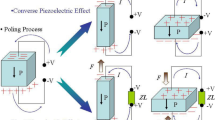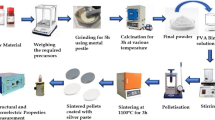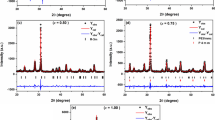Abstract
In general, Pb(Sb1/2Nb1/2)–PbTiO3–PbZrO3 (PSN–PZT) is regarded as a ternary system. However, little information about this system has been reported so far. In this paper, xPb(Sb1/2Nb1/2)O3–(1 − x)Pb(Zr0.54Ti0.46)O3 ceramics were studied systematically by X-ray diffraction, SEM observation and electrical measurements. X-ray diffraction analyses show that PSN is neither perovskite structure nor a single phase structure. PSN–PZT isn’t a ternary system. 6 mol% is the maximum value of PSN to form a single perovskite structure in xPSN–(1 − x)Pb(Zr0.54Ti0.46)O3 ceramics. To alter the Sb/Nb molar ratio, it is found that the solid solubility of Sb3+ ion in Pb(Zr0.54Ti0.46)O3 lattice is much smaller than that of Nb5+ ion and determines the solid solubility of PSN in PZT. For the chemical composition of 0.08PbNbO3–0.92Pb(Zr0.54Ti0.46)O3, excellent properties of ε r = 2078, tanδ = 2.31%, d 33 = 449 pC/N, k p = 0.69, Q m = 65 and T C = 322 °C can be achieved. These properties are superior to that of all compositions with Sb/Nb = 1/1, indicating that the 1/1 ratio of Sb/Nb isn’t the optimal combination for the best electrical properties.







Similar content being viewed by others
References
B. Jaffe, R.S. Roth, S. Marzullo, J. Appl. Phys. 25, 809 (1954)
H. Jaffe, P. Ceramics, J. Am. Ceram. Soc. 41, 494 (1958)
H. Ouchi, K. Nagano, S. Hayakawa, J. Am. Ceram. Soc. 48, 630 (1965)
E.F. Alberta, A.S. Bhalla, T. Takenaka, Ferroelectrics 188, 109 (1996)
M.M. Nadoliisky, T.K. Vassileva, P.B. Vitkov, Ferroelectrics 129, 141 (1992)
M.H. Lee, K.H. Kim, C.K. Yang, in Sixth IEEE International Symposium on Applications of Ferroelectrics, p. 422, (1986)
Y. Kawamura, H. Ohuchi, Jpn. J. Appl. Phys. 33, 5332 (1994)
C. Tapaonoi, S. Tashiro, H. Igarashi, Jpn. J. Appl. Phys. 33, 5336 (1994)
H. Ohuchi, Y. Kawamura, Jpn. J. Appl. Phys. 34, 5298 (1995)
N. Ichinose, H. Egami. K. Yokoyama, Y. Tanno, in Abstract Annual Meeting Four Electric Engineering, p. 402, (1969)
R.E. Carbonio, J.A. Alonso, J.L. Martínez, J. Phys. Condens. Matter 11, 361 (1999)
K. Uchino, S. Nomura, Ferroelectrics 44, 55 (1982)
L.E. Cross, Ferroelectrics 76, 241 (1987)
Z. Ling, W. Qiu, K. Wang, Electron. Compon. Mater. 8, 10 (2005)
E.G. Fesenko, A.Y. Dantsiger, L.A. Resnitchenko, M.F. Kupriyanov, Ferroelectrics 41, 137 (1982)
L. Wu, C. Wei, T. Wu, C. Teng, J. Phys. C: Solid State Phys. 16, 2803 (1983)
C.H. Wang, Ceram. Int. 30, 605 (2004)
J. Chen, M.P. Harmer, J. Am. Ceram. Soc. 73, 68 (1990)
J.C. Wurst, J.A. Nelson, J. Am. Ceram. Soc. 55, 109 (1972)
M. Pereira, A.G. Peixoto, M.J.M. Gomes, J. Eur. Ceram. Soc. 21, 1353 (2001)
Acknowledgements
The authors are thankful to Datong Zhang of South China University of Technology, China, for helping us obtain SEM images and Jingpei Cai of School of Materials Science and Engineering, South China University of Technology, China for helping us obtain XRD data.
Author information
Authors and Affiliations
Corresponding author
Rights and permissions
About this article
Cite this article
Zhuo, Z., Ling, Z. & Liu, Y. Phase composition and piezoelectric properties of Pb(Sb1/2Nb1/2)–PbTiO3–PbZrO3 ceramics. J Mater Sci: Mater Electron 29, 9524–9530 (2018). https://doi.org/10.1007/s10854-018-8986-3
Received:
Accepted:
Published:
Issue Date:
DOI: https://doi.org/10.1007/s10854-018-8986-3




